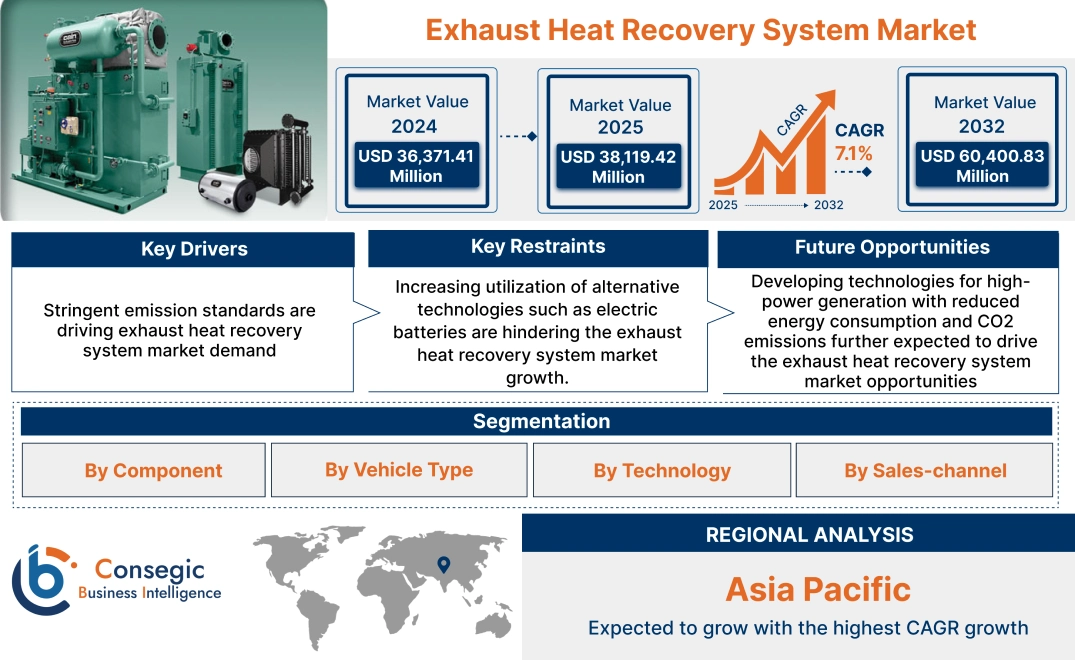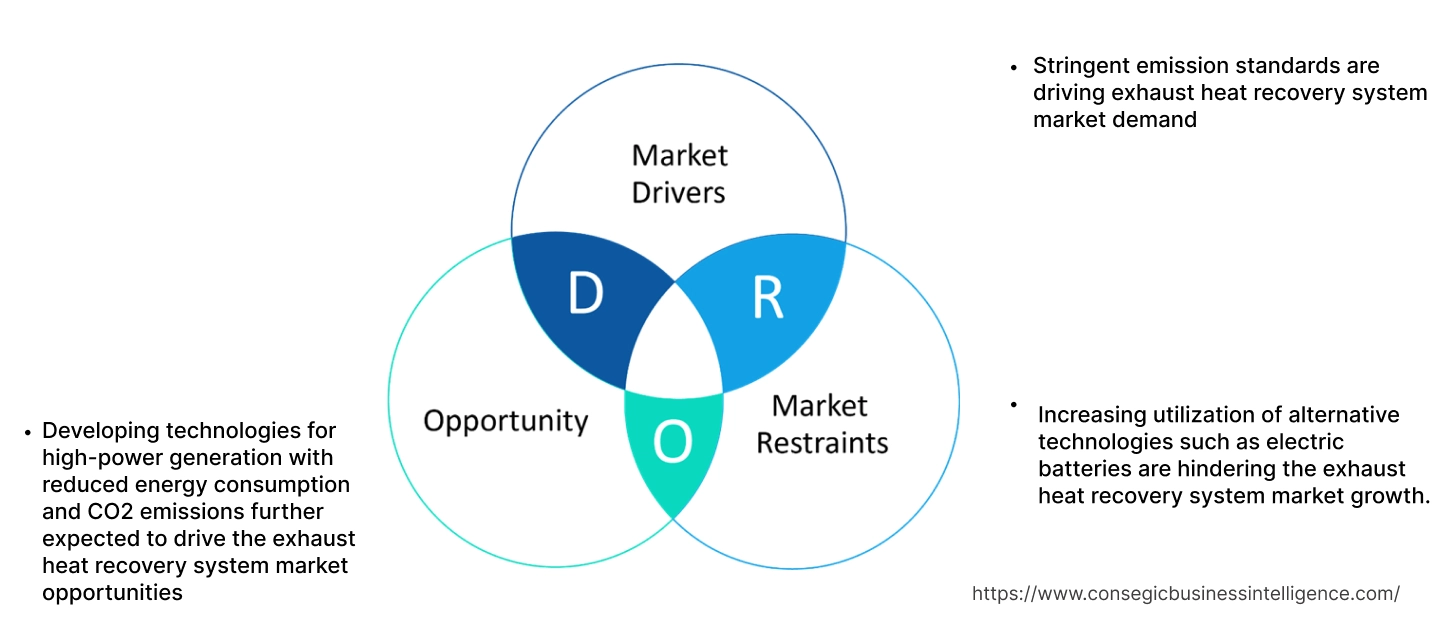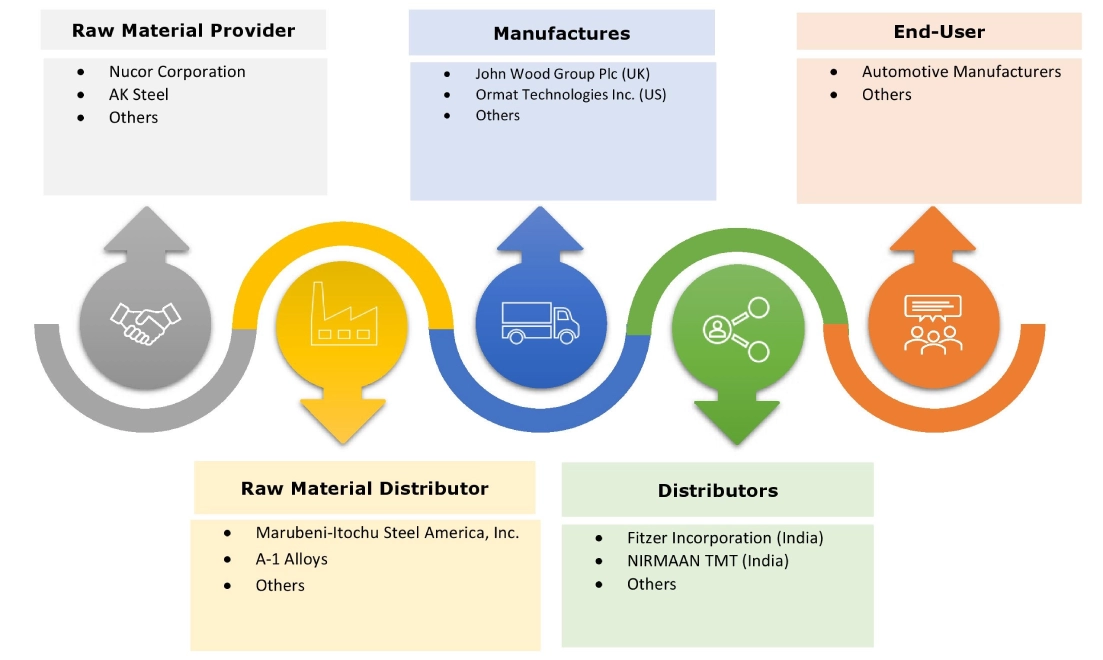- Summary
- Table Of Content
- Methodology
Exhaust Heat Recovery System Market Size:
Exhaust Heat Recovery Market is estimated to reach over USD 60,400.83 Million by 2032 from a value of USD 36,371.41 Million in 2024 and is projected to grow by USD 38,119.42 Million in 2025, growing at a CAGR of 7.1% from 2025 to 2032.
Exhaust Heat Recovery System Market Scope & Overview:
Exhaust Heat Recovery System (EHRS) is designed to capture and reuse the heat energy from the exhaust gases of an internal combustion engine. The EHR system improves overall energy by converting waste heat energy into useful energy forms. Moreover, this technology can be used in car, truck or SUV with an internal combustion engine, and also in hybrid vehicles to recover useable energy in the form of electrical energy.
Key Drivers:
Stringent emission standards are driving exhaust heat recovery system market demand
Stringent emission standards such as 6d, 6a, Via and others enforce reductions in the harmful nitrogen oxide emissions from diesel vehicles. These regulations compel the government to adopt systems including exhaust heat recovery to reduce harmful emissions from diesel engines. Furthermore, countries like China and India are implementing emission standards to reduce nitrogen oxide (NOx) emissions in the atmosphere.
- For instance, in 2023, according to International Trade Administration, China’s Ministry of Ecology and Environment (MEE) implemented 6a and Via emission standards for the vehicles including light-duty trucks, passenger vehicles and others. These emission standards mandate diesel vehicles to incorporate exhaust heat recovery system to reduce nitrogen oxide emission in the atmosphere.
Thus, stringent emission standards like Euro 6d, 6a, Via and others are driving exhaust heat recovery system market expansion, by enforcing the diesel vehicles to exhaust heat recovery to reduce nitrogen oxide emissions.
Key Restraints:
Increasing utilization of alternative technologies such as electric batteries are hindering the exhaust heat recovery system market growth.
The rising adoption of alternative technologies such as electric batteries are emerging as a significant restraint in the exhaust heat recovery system market. Governments and manufacturers worldwide are heavily investing in these technologies to achieve zero emission goals, driven by stringent environmental regulations and consumer demand for green transportation. Electric batteries eliminate the need for internal combustion system, also gaining traction due to advancement in charging infrastructure.
Therefore, the adoption of alternative technologies are hindering the exhaust heat recovery system market share.
Future Opportunities :
Developing technologies for high-power generation with reduced energy consumption and CO2 emissions further expected to drive the exhaust heat recovery system market opportunities
The heat recovery system are increasingly integrated with advanced technologies, reducing the dependence on conventional energy sources, and increasing the use of recycled and renewable energy for a more sustainable environment. Moreover, advanced technologies help in generating huge amount of power for captive consumption while reducing energy use and reduce CO2 emissions by up to several Ktons per year.
- For instance, in September 2024, Heidelberg Materials launched USD 30 million project, which has the potential to generate up to 20 MW of power for captive consumption. Heidelberg Materials Egypt is employing this innovation to decrease energy use and reduce CO2 emissions by up to 40 Ktons per year.
Therefore, as per the analysis, the rising advancements in technologies to reduce CO2 emissions and increase power generation are driving the exhaust heat recovery system market opportunities.
Exhaust Heat Recovery System Market Segmental Analysis :
By Component:
Based on the component, the market is segmented into turbine, TEG module, compressor, EGR valve, EGR cooler, expander, pump, condenser, heat-exchanger, and evaporator.
Trends in the Component:
- Exhaust gas recirculation (EGR) is widely used to control NOx emissions from diesel engines.
- The increasing adoption of Thermo-electric generators (TEGs) for converting waste heat directly into electricity.
EGR valve accounted for the largest revenue share in the year 2024.
- The exhaust gas recirculation redirects a portion of exhaust gases back into the engine's intake to reduce emissions and control combustion temperatures, improving fuel efficiency and minimizing pollutants.
- Additionally, EGR directs around 30% of the exhaust gas back into the engine, while the remaining 70% reaches the traditional exhaust gas boiler after the turbocharger.
- For instance, Aalborg EGR-HPE has a minimal carbon footprint and is completely integrated with the engine. It provides high-quality service steam, steam temperatures of 400 °c, greatly increased turbine power generation, and effective waste heat recovery at lower engine loads.
- Thus, as per the analysis, the capability of EGR to reduce NOx is driving the exhaust heat recovery system market growth.
Thermo-electric generator is anticipated to register the fastest CAGR during the forecast period.
- Thermoelectric generator works on the principle of ‘Seebeck Effect’ (a phenomenon in which a temperature difference between two dissimilar electrical conductors produces a voltage difference between the two substances), can convert thermal energy into electricity from the temperature differential.
- Thermoelectricity can be used to generate electricity from any source of heat, including renewable sources such as solar and geothermal energy. It can also improve the efficiency of power plants and other industrial facilities by recovering wasted heat and converting it into usable electricity.
- Thermoelectric generators have several advantages such as high-efficiency, long-term stability, and low environmental impact.
- For instance, Researchers at International Advanced Research Center for Powder Metallurgy and New Materials (ARCl), developed a thermoelectric generator which converts the waste heat from an auto exhaust into useful power. It is a 200-Watt thermoelectric generator (TEG) that can convert waste heat from the automotive exhaust into DC power.
- Thus, based on the analysis, the advanced capabilities of thermos-electric generator are driving the exhaust heat recovery system market expansion.
By Vehicle Type:
Based on the vehicle type, the market is segmented into passenger vehicle, heavy commercial vehicle, and light commercial vehicle.
Trends in the Vehicle Type:
- The wide use of EHRS to reduce the fuel consumption in passenger vehicles and thus reducing emissions.
- Exhaust heat recovery system’s cost-effective approach and reduction of greenhouse gas emission per heavy commercial vehicle is increasing its adoption.
HCV accounted for the largest revenue share of 48.21% in the year 2024.
- Heavy trucks have robust suspension systems and more powerful engines, thus are widely utilized for hauling equipment and materials, transporting heavy machinery and pipes, pulling loaded logging trailers.
- Additionally, heavy duty trucks are the most suitable machines to use, as they have large capacities and enhanced transmissions.
- Moreover, the fuel consumption of a 4.5-ton forklift can be reduced through the fast warm-up of the auto-transmission fluid by recovering the heat of exhaust gas.
- For instance, according to the international council of clean transportation, in China the total heavy truck sale accounted for 90% including 55% of diesel trucks and 35% of natural gas powered truck. This is further driving the utilization of EHRS in heavy commercial vehicles.
- Thus, based on the analysis, the wide usage of heavy-commercial vehicles is propelling the exhaust heat recovery system market trends.
Passenger vehicles are anticipated to register the fastest CAGR during the forecast period.
- Hybrid Electric Vehicles (HEVs) and Electric Vehicles (EVs) were introduced in the passenger car market to improve the fuel efficiency of motor vehicles and reduce pollutant emissions.
- Moreover, refining heat recovery system designed to improve efficiency and reduce power consumption requirements.
- For instance, in August 2024, Hanon Systems, announced the development of the world’s first 4th generation heat pump system, a key thermal management component for electric to employ a parallel heat source recovery method, utilizing waste heat from the motor and battery.
- Thus, the increasing integration of heat recovery system in passenger vehicle further drives the exhaust recovery system market trends.
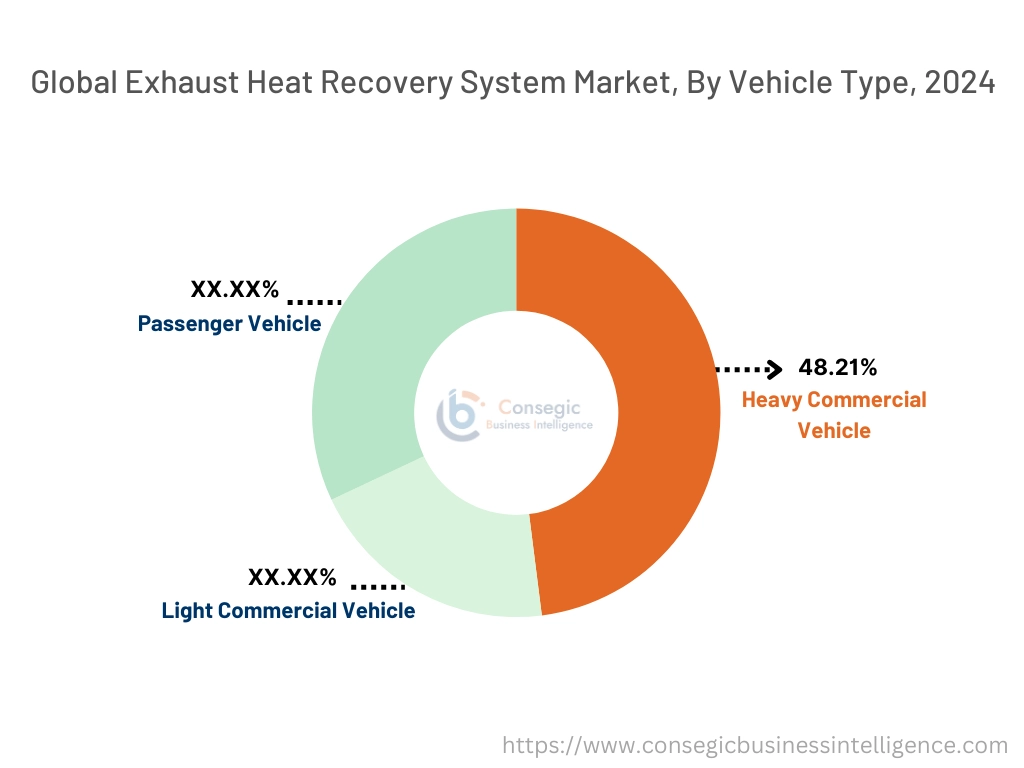
By Technology:
Based on the technology, the market is segmented into exhaust gas recirculation, organic Rankine cycle, turbocharger, and thermoelectric generator
Trends in the Technology:
- Due to the increasing trend of rising fuel prices and concern about global warming, companies are facing pressure to reduce greenhouse gas emissions and improve the energy efficiency of their installations.
- The wide integration of technologies such as organic rankine cycles and thermoelectric generators in automobile exhaust heat recovery.
EGR for the largest revenue share in the year 2024
- With EGR technology, exhaust gas is recirculated and mixed with fresh air in engine, and this mixture has a higher heat capacity and lowers oxygen concentration.
- Moreover, gas turbines use exhaust gas recirculation to modify the combustion process resulting in higher levels of CO2 in the exhaust stream and lower levels of oxygen while simultaneously reducing total exhaust flow to the carbon capture system.
- For instance, in October 2024, GE Vernova’s Exhaust Gas Recirculation (EGR) system is registered to reduce more than 6% of the total cost of the carbon capture facility, as compared to installing carbon capture without the EGR system.
- Thus, based on the analysis, the reduction in carbon emission due to the installation of EGR systems is driving the exhaust heat recovery system market trends.
Turbocharger is anticipated to register the fastest CAGR during the forecast period.
- Turbochargers capture and reuse exhaust gases to drive a turbine that boosts engine performance, becoming and ideal option in both automotive and industrial applications.
- Turbochargers significantly improve fuel efficiency and reduces emissions aligning with stringent environmental regulations and consumer demand for high-performance vehicles.
- For instance, Cummins launched new turbocharger designed specifically for hydrogen internal combustion engines (H2 ICE). This advancement in turbocharging technology marks a significant milestone for heavy-duty commercial on-highway applications.
- Thus, the advanced functionalities of turbocharger is driving the exhaust heat recovery system market size.
By Sales Channel:
Based on the sales channel, the market is segmented into OEMs and aftermarket
Trends in the Sales-channel:
- Aftermarket upgraders is the use of a ceramic coating applied via thermal spraying for reducing heat loss.
- The increasing trend of OEMs electrification and hybridization for enhancing fuel efficiency and reducing carbon footprints.
OEMs for the largest revenue in the year 2024 and is also anticipated to register the fastest CAGR during the forecast period.
- OEMs produce components to sell to other companies that integrate the parts into their products.
- Moreover, OEMs are known for their strict requirements and specifications while sourcing products and services.
- For instance, Thermal Systems is a leading EPC/OEM organization with nearly 4 decades of experience in providing turnkey solutions from Concept to commissioning of heat recovery systems and custom-designed heat recovery equipment for varied applications in process & power industries.
- Thus, based on the analysis, the capabilities of OEMs for product optimization, and enhanced manufacturing processes is driving the exhaust heat recovery system market size.
Regional Analysis:
The regions covered are North America, Europe, Asia Pacific, Middle East and Africa, and Latin America.
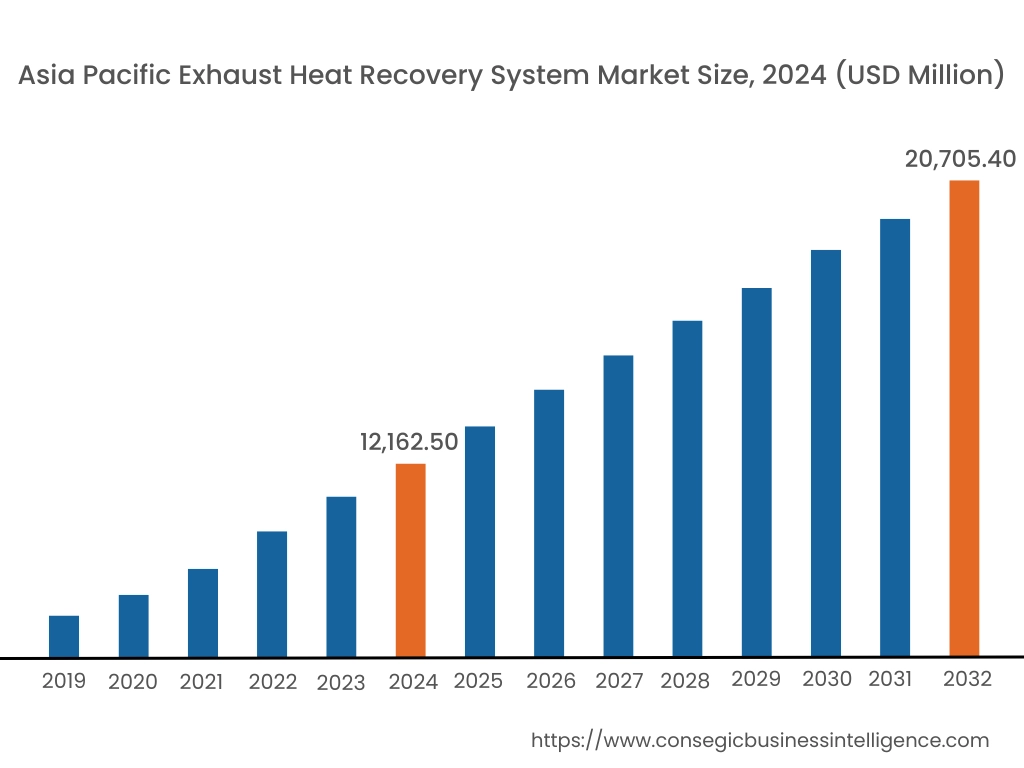
Asia Pacific region was valued at USD 12,162.50 Million in 2024. Moreover, it is projected to grow by USD 12,773.72 Million in 2025 and reach over USD 20,705.40 Million by 2032. Out of this, China accounted for the maximum revenue share of 32.5%. The Asia Pacific region is witnessing rapid industrialization and urbanization creating a surge in energy demand, making exhaust heat recovery system adoption essential for efficiency. Countries such as China, India, and Japan are implementing stricter emission standards and energy-efficiency mandates, encouraging industries to adopt heat recovery systems. The growing automotive technologies particularly in hybrid and electric vehicles is another significant driver. Moreover, key manufacturers in the region are also innovating advanced technologies to reduce the carbon footprint, which in turn, is boosting the exhaust heat recovery system market share.
- For instance, in May 2023, Schaeffler featured latest 4in1 electric axle which combines individual subsystems electric motor, transmission, power electronics, and thermal management into one integrated system. Also, its featured solutions include reduction in C02 emissions, renewable energy and hydrogen, powertrain innovations.
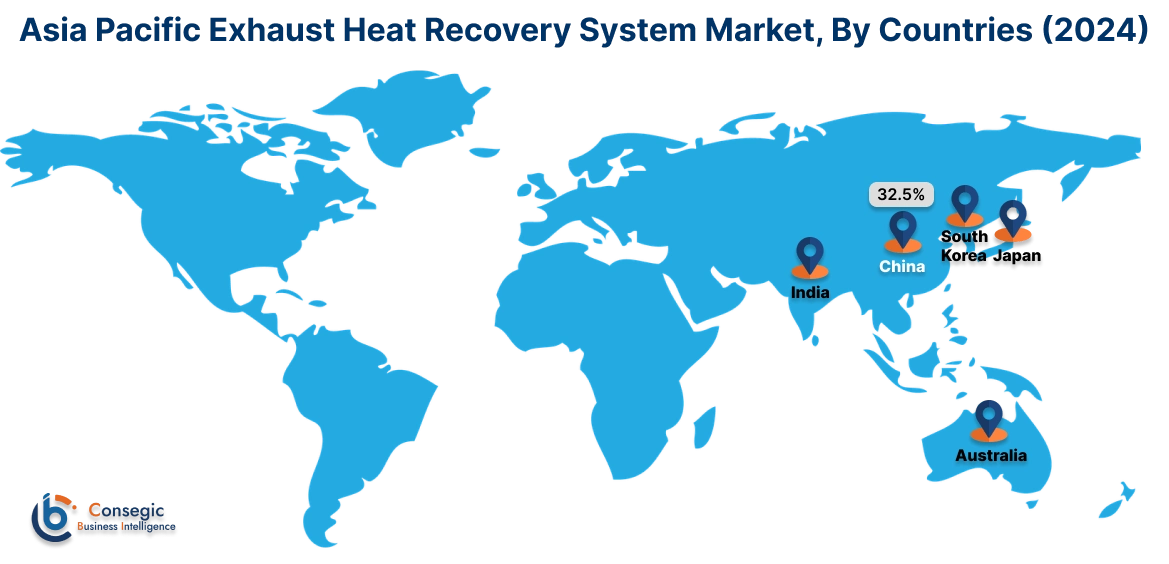
North America is estimated to reach over USD 16,127.02 Million by 2032 from a value of USD 9,836.47 Million in 2024 and is projected to grow by USD 10,298.27 Million in 2025. The growth in North America region is due to the strict government regulations aimed at reducing emissions and improving fuel efficiency. The US environmental protection agency and Canada’s environmental policies encourage the use of energy-efficient technologies in the automotive and industrial sector. Government regulations on energy conservation and efficiency, tax breaks and other government incentives are some of the factors that make the exhaust heat recovery system market apart from the fact that the region is known for its continuous technological development period all in the heat recovery business providing ongoing opportunities for the market growth.
- For instance, Paccar’s, Peterbilt SuperTruck II is developed to improve the efficiency of goods transportation. The SuperTruck II features an advanced clean diesel engine that uses waste heat recovery to achieve a 55% Brake thermal efficiency improvement, an efficient 48-volt mild hybrid powertrain, electrified engine accessories and enhanced aerodynamics.
The growth in European region of exhaust heat recovery system market is due to their innovation and market leadership. Government initiatives focusing on sustainability, energy efficiency, and innovation are providing a conducive environment for expansion. Additionally, increasing awareness among consumers and businesses regarding the benefits of eco-friendly products and services is fueling demand. Moreover, the MEA region are reducing dependence on fossil fuels as the region’s abundant oil and gas industries generate significant waste heat creating a large potential for recovery and reuse. Further, in Latin America region exhaust heat recovery system adoption is increasing as government and industry strive to meet global climate commitment and reduce energy use further driving exhaust heat recovery system market demand.
Top Key Players and Market Share Insights:
The global exhaust heat recovery system market is highly competitive with major players providing solutions to the national and international markets. Key players are adopting several strategies in research and development (R&D), product innovation, and end-user launches to hold a strong position in the exhaust heat recovery industry. Key players in the exhaust heat recovery system industry include-
- John Wood Group Plc (UK)
- Ormat Technologies Inc. (US)
- General Electric Co. (US)
- Thermax Limited (India)
- Cool Energy Inc. (Colorado)
- Calsonic Kansei (Japan)
- Mitsubishi Heavy Industries Ltd. (Japan)
- Faurecia (France)
- Continental (Germany)
- Echogen Power Systems Inc. (US)
- Econotherm Ltd. (UK)
- Siemens AG (Germany)
Recent Industry Developments :
Partnerships & Collaborations:
- In September 2023, TITAN and Orcan Energy partnered to exploit the benefits and explore the scale-up potential of new modular technology pioneered by Orcan Energy which holds the potential to convert large waste heat volumes into clean and affordable energy.
- In February 2024, Cemex and Orcan Energy partnered to decarbonize cement production through waste heat recovery. Building on the initial waste heat recovery collaboration at the cement plant in Rüdersdorf, Germany, the partners will start to exploit Orcan Energy’s flexible and modular technology for Cemex globally.
Exhaust Heat Recovery System Market Report Insights :
| Report Attributes | Report Details |
| Study Timeline | 2019-2032 |
| Market Size in 2032 | USD 60,400.83 Million |
| CAGR (2025-2032) | 7.1% |
| By Component |
|
| By Vehicle Type |
|
| By Technology |
|
| By Sales-channel |
|
| By Region |
|
| Key Players |
|
| North America | U.S. Canada Mexico |
| Europe | U.K. Germany France Spain Italy Russia Benelux Rest of Europe |
| APAC | China South Korea Japan India Australia ASEAN Rest of Asia-Pacific |
| Middle East and Africa | GCC Turkey South Africa Rest of MEA |
| LATAM | Brazil Argentina Chile Rest of LATAM |
| Report Coverage |
|
Key Questions Answered in the Report
How big is the Exhaust Heat Recovery System market? +
Exhaust Heat Recovery Market is estimated to reach over USD 60,400.83 Million by 2032 from a value of USD 36,371.41 Million in 2024 and is projected to grow by USD 38,119.42 Million in 2025, growing at a CAGR of 7.1% from 2025 to 2032.
What specific segmentation details are covered in the Exhaust Heat Recovery System report? +
The Exhaust Heat Recovery report includes specific segmentation details for component, vehicle type, technology, sales-channel, and regions.
Which is the fastest segment anticipated to impact the market growth? +
In the Exhaust Heat Recovery market, the turbocharger is the fastest-growing segment during the forecast period.
Who are the major players in the Exhaust Heat Recovery market? +
The key participants in the Exhaust Heat Recovery market are John Wood Group Plc (UK), Ormat Technologies Inc. (US), General Electric Co. (US), Mitsubishi Heavy Industries Ltd. (Japan), Faurecia (France), Continental (Germany), Echogen Power Systems Inc. (US), Econotherm Ltd. (UK), Thermax Limited (India), Calsonic Kansei (Japan), Siemens AG (Germany), Cool Energy Inc. (Colorado), and others.
